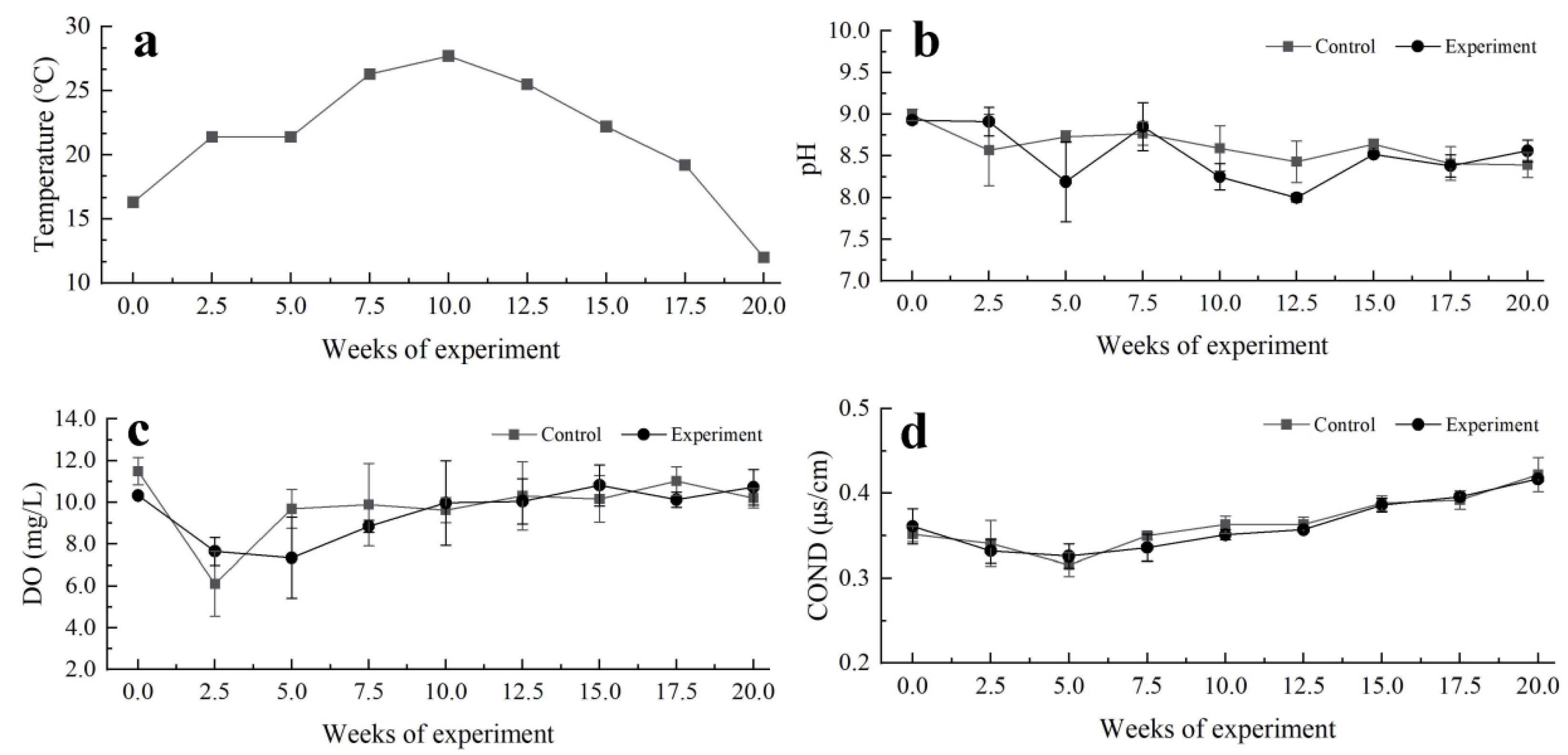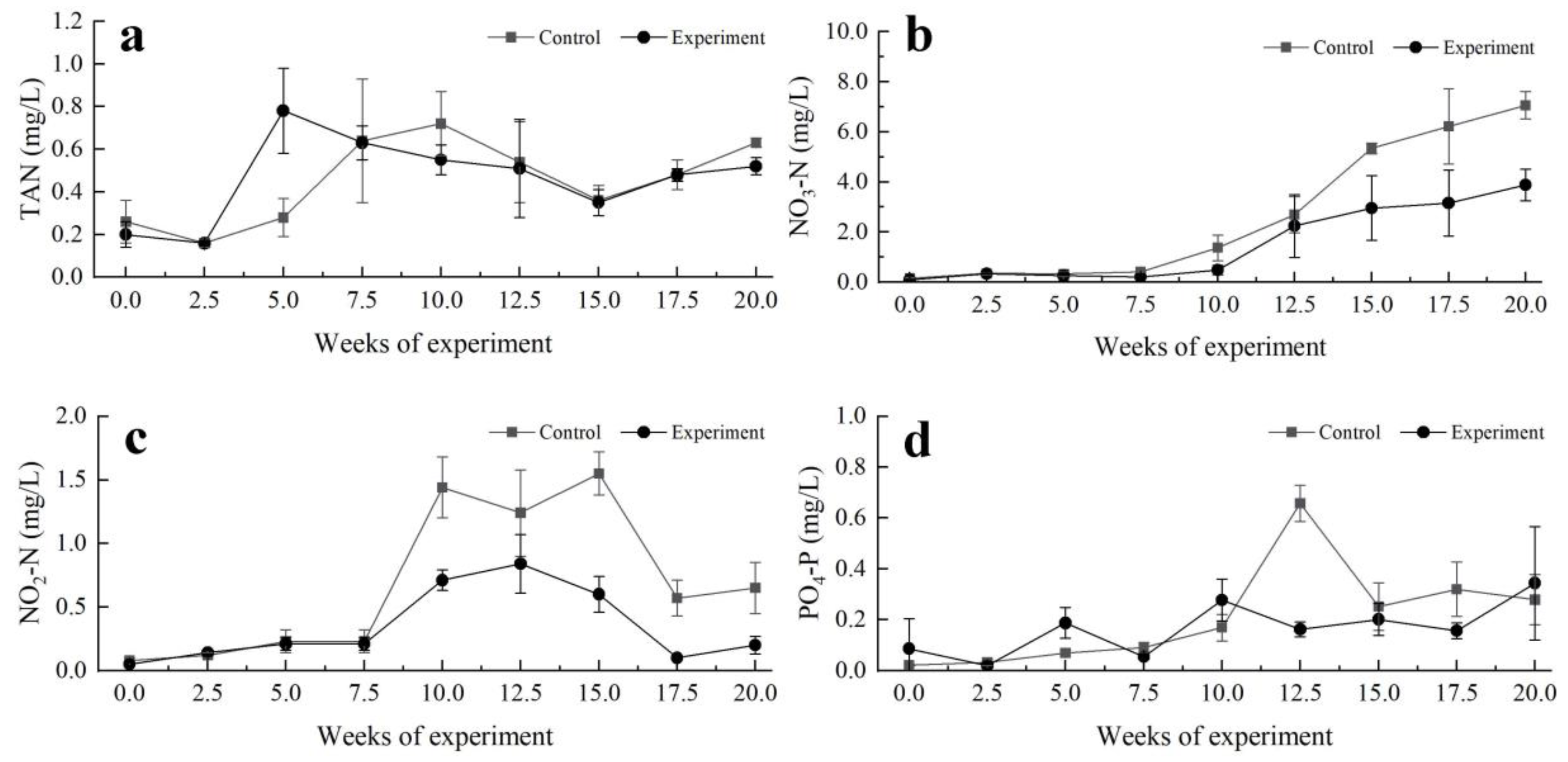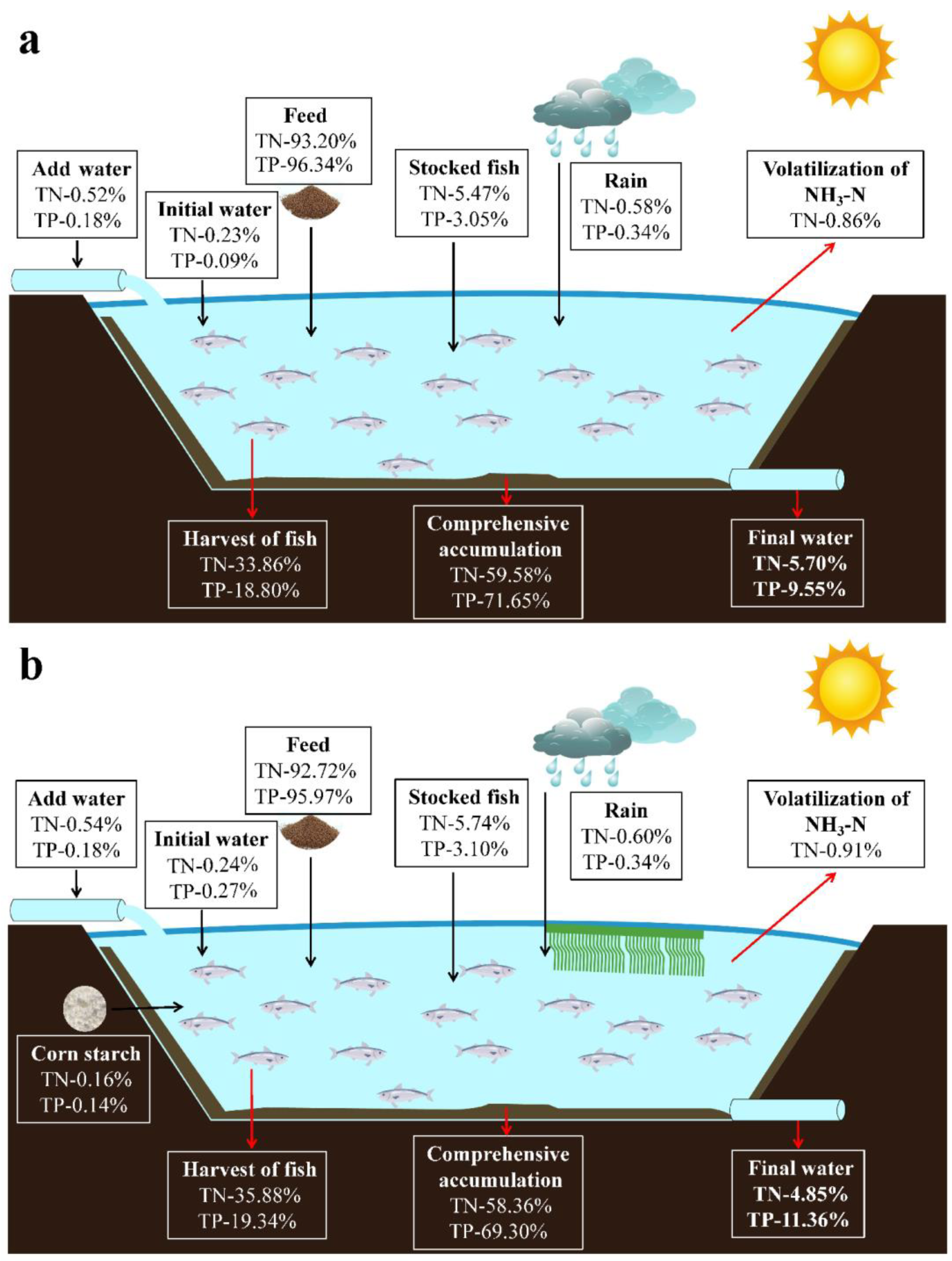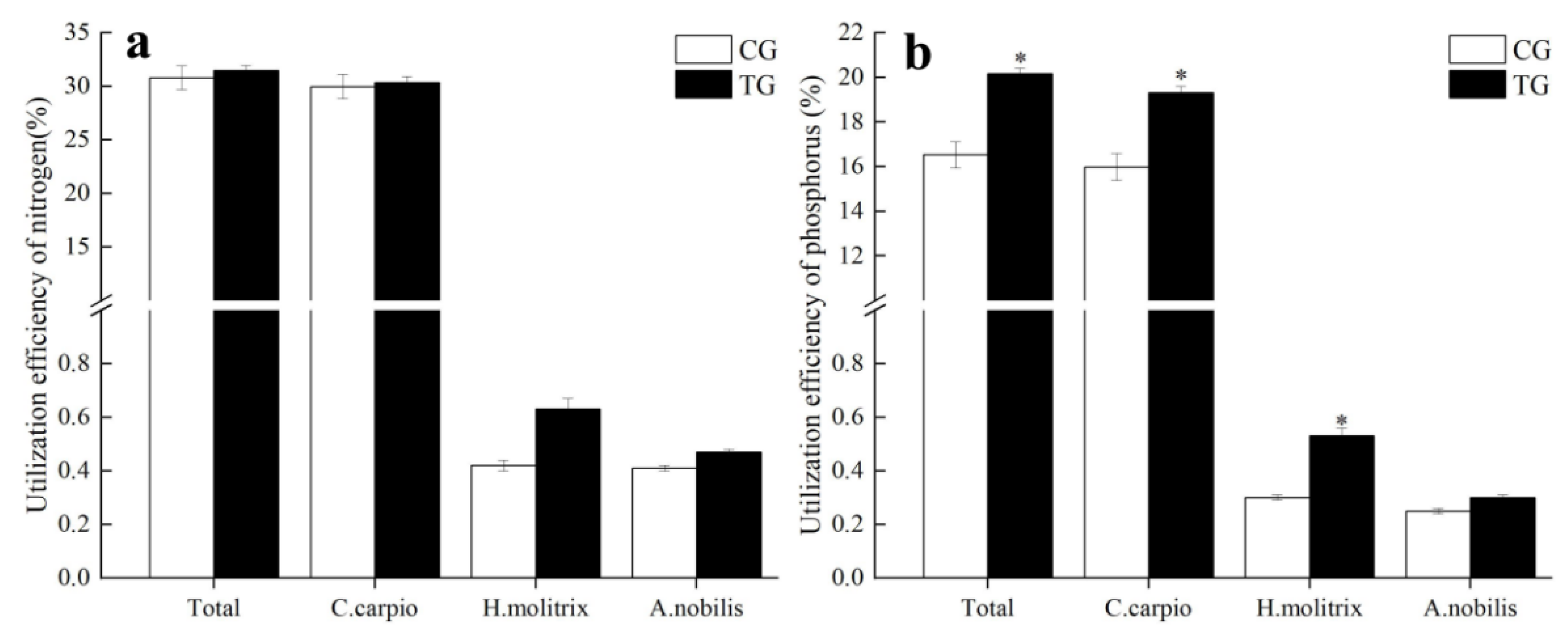Combined Effects of Eco-Substrate and Carbon Addition on Water Quality, Fish Performance and Nutrient Budgets in the Pond Polyculture System
Abstract
1. Introduction
2. Materials and Methods
2.1. Ethics Statement
2.2. Study Site and Experimental Design
2.3. Fish Stocking and Management
2.4. Fish Performance Parameters
2.5. Water Quality Parameters
2.6. Nitrogen and Phosphorus Budget
2.7. Nitrogen and Phosphorus Utilization Efficiency
2.8. Statistical Analysis
3. Results
3.1. Water Quality Parameters
3.2. Growth and Yields
3.3. Nutrient Budgets
3.4. Nitrogen and Phosphorus Utilization Efficiency by Cultured Fish
4. Discussion
5. Conclusions
Author Contributions
Funding
Institutional Review Board Statement
Data Availability Statement
Acknowledgments
Conflicts of Interest
References
- FAO. The State of World Fisheries and Aquaculture 2020. Sustainability in Action; Food and Agriculture Organization of the United Nations: Rome, Italy, 2020. [Google Scholar]
- Fiorella, K.J.; Okronipa, H.; Baker, K.; Heilpern, S. Contemporary aquaculture: Implications for human nutrition. Curr. Opin. Biotech. 2021, 70, 83–90. [Google Scholar] [CrossRef] [PubMed]
- Bureau of Fisheries and Management, Ministry of Agriculture and Rural Affairs of China. China Fishery Statistical Yearbook of 2021; China Agriculture Press: Beijing, China, 2020. (In Chinese) [Google Scholar]
- Páez-Osuna, F. The environmental impact of shrimp aquaculture: Causes, effects, and mitigating alternatives. Environ. Manag. 2001, 28, 131–140. [Google Scholar] [CrossRef] [PubMed]
- Yep, B.; Zheng, Y. Aquaponic trends and challenges: A review. J. Clean. Prod. 2019, 228, 1586–1599. [Google Scholar] [CrossRef]
- Gross, A.; Boyd, C.E.; Wood, C.W. Nitrogen transformations and balance in channel catfish ponds. Aquac. Eng. 2000, 24, 1–14. [Google Scholar] [CrossRef]
- Avnimelech, Y.; Ritvo, G. Shrimp and fish pond soils: Processes and management. Aquaculture 2003, 220, 549–567. [Google Scholar] [CrossRef]
- Anh, P.T.; Kroeze, C.; Bush, S.R.; Mol, A.P.J. Water pollution by intensive brackish shrimp farming in south-east Vietnam: Causes and options for control. Agric. Water Manag. 2010, 97, 872–882. [Google Scholar] [CrossRef]
- John, E.M.; Krishnapriya, K.; Sankar, T.V. Treatment of ammonia and nitrite in aquaculture wastewater by an assembled bacterial consortium. Aquaculture 2020, 526, 735390. [Google Scholar] [CrossRef]
- Santorio, S.; Couto, A.T.; Amorim, C.L.; Rio, A.V.D.; Arregui, L.; Mosquera-Corral, A.; Castro, P.M.L. Sequencing versus continuous granular sludge reactor for the treatment of freshwater aquaculture effluents. Water Res. 2021, 201, 117293. [Google Scholar] [CrossRef]
- Pekkoh, J.; Chaichana, C.; Thurakit, T.; Phinyo, K.; Lomakool, S.; Ruangrit, K.; Duangjan, K.; Suwannarach, N.; Kumla, J.; Cheirsilp, B.; et al. Dual-bioaugmentation strategy to enhance the formation of algal-bacteria symbiosis biofloc in aquaculture wastewater supplemented with agricultural wastes as an alternative nutrient sources and biomass support materials. Bioresour. Technol. 2022, 359, 127469. [Google Scholar] [CrossRef]
- Zhao, Z.G.; Xu, Q.Y.; Luo, L.; Qiao, G.; Wang, L.S.; Li, J.N.; Wang, C.A. Effect of bio-floc on water quality and the production performance of bottom and filter feeder carp fed with different protein levels in a pond polyculture system. Aquaculture 2021, 531, 735906. [Google Scholar] [CrossRef]
- Ebrahimi, A.; Akrami, R.; Najdegerami, E.H.; Ghiasvand, Z.; Koohsari, H. Effects of different protein levels and carbon sources on water quality, antioxidant status and performance of common carp (Cyprinus carpio) juveniles raised in biofloc based system. Aquaculture 2020, 516, 734639. [Google Scholar] [CrossRef]
- Gaona, C.A.P.; de Almeida, M.S.; Viau, V.; Poersch, L.H.; Wasielesky, W. Effect of different total suspended solids levels on a Litopenaeus vannamei (Boone, 1931) BFT culture system during biofloc formation. Aquac. Res. 2017, 48, 1070–1079. [Google Scholar] [CrossRef]
- Asaduzzaman, M.; Wahab, M.A.; Verdegem, M.C.J.; Huque, S.; Salam, M.A.; Azim, M.E. C/N ratio control and substrate addition for periphyton development jointly enhance freshwater prawn Macrobrachium rosenbergii production in ponds. Aquaculture 2008, 280, 117–123. [Google Scholar] [CrossRef]
- Pandey, P.K.; Bharti, V.; Kumar, K. Biofilm in aquaculture production. Afr. J. Microbiol. Res. Rev. 2014, 8, 1434–1443. [Google Scholar] [CrossRef][Green Version]
- Uddin, M.S.; Azim, M.E.; Wahab, M.A.; Verdegem, M.C.J. Effects of substrate addition and supplemental feeding on plankton composition and production in tilapia (Oreochromis niloticus) and freshwater prawn (Macrobrachium rosenbergii) polyculture. Aquaculture 2009, 297, 99–105. [Google Scholar] [CrossRef]
- Zhang, K.; Yu, D.G.; Li, Z.F.; Xie, J.; Wang, G.J.; Gong, W.B.; Yu, E.M.; Tian, J.J. Influence of eco-substrate addition on organic carbon, nitrogen and phosphorus budgets of intensive aquaculture ponds of the Pearl River, China. Aquaculture 2020, 520, 734868. [Google Scholar] [CrossRef]
- Arnold, S.J.; Coman, F.E.; Jackson, C.J.; Groves, S.A. High-intensity, zeroexchange production of juvenile tiger shrimp, Penaeus monodon: An evaluation of artificial substrates and stocking density. Aquaculture 2009, 293, 42–48. [Google Scholar] [CrossRef]
- Kumar, V.S.; Pandey, P.K.; Anand, T.; Bhuvaneswari, R.; Kunmar, S. Effect of periphyton (aquamat) on water quality, nitrogen budget, microbial ecology, and growth parameters of Litopenaeus vannamei in a semi-intensive culture system. Aquaculture 2017, 479, 240–249. [Google Scholar] [CrossRef]
- Kumar, S.; Anand, P.S.S.; De, D.; Ghoshal, T.K.; Alavandi, S.V.; Vijayan, K.K. Integration of substrate in biofloc based system: Effects on growth performance, water quality and immune responses in black tiger shrimp, Penaeus monodon culture. Aquac. Res. 2019, 50, 2986–2999. [Google Scholar] [CrossRef]
- Ortiz-Estrada, Á.M.; Gollas-Galván, T.; Martínez-Córdova, L.R.; Burgos-Hernández, A.; Scheuren-Acevedo, S.M.; Emerenciano, M.; Martínez-Porchas, M. Diversity and bacterial succession of a phototrophic biofilm used as complementary food for shrimp raised in a super-intensive culture. Aquac. Int. 2019, 27, 581–596. [Google Scholar] [CrossRef]
- Addo, F.G.; Zhang, S.H.; Manirakiza, B.; Ohore, O.E.; Yuan, S.D. The impacts of straw substrate on biofloc formation, bacterial community and nutrient removal in shrimp ponds. Bioresour. Technol. 2021, 326, 124727. [Google Scholar] [CrossRef] [PubMed]
- SEPA. Monitoring and Analytical Method of Water and Wastewater, 4th ed.; Environmental and Scientific Press of China: Beijing, China, 2002. (In Chinese) [Google Scholar]
- GB/T 6437; Determination of Phosphorus in Feed-Spectphotometry. National Standardization Management Council of China: Beijing, China, 2018. (In Chinese)
- Weiler, R.R. Rate of loss of ammonia from water to the atmosphere. J. Fish. Res. Board Can. 2011, 36, 685–689. [Google Scholar] [CrossRef]
- Ebeling, J.M.; Timmons, M.B.; Bisogni, J.J. Engineering analysis of the stoichiometry of photoautotrophic, autotrophic, and heterotrophic removal of ammonia-nitrogen in aquaculture systems. Aquaculture 2006, 257, 346–358. [Google Scholar] [CrossRef]
- Lin, Y.C.; Chen, J.C. Acute toxicity of nitrite on Litopenaeus vannamei (Boone) juveniles at different salinity levels. Aquaculture 2003, 224, 193–201. [Google Scholar] [CrossRef]
- Esam, F.; Khalafalla, M.M.; Gewaily, M.S.; Abdo, S.; Hassan, A.M.; Dawood, M.A.O. Acute ammonia exposure combined with heat stress impaired the histological features of gills and liver tissues and the expression responses of immune and antioxidative related genes in Nile tilapia. Ecotox. Environ. Saf. 2022, 231, 113187. [Google Scholar] [CrossRef]
- Foss, A.; Imsland, A.K.; Roth, B.; Schram, E.; Stefansson, S.O. Effects of chronic and periodic exposure to ammonia on growth and blood physiology in juvenile turbot (Scophthalmus maximus). Aquaculture 2009, 296, 45–50. [Google Scholar] [CrossRef]
- Jensen, F.B. Nitrite disrupts multiple physiological functions in aquatic animals. Comp. Biochem. Physiol. A 2003, 135, 9–24. [Google Scholar] [CrossRef]
- Lezama-Cervantes, C.; Paniagua-Michel, J. Effects of constructed microbial mats on water quality and performance of Litopenaeus vannamei post-larvae. Aquac. Eng. 2010, 42, 75–81. [Google Scholar] [CrossRef]
- Collos, Y.; Vaquer, A.; Bibent, B.; Souchu, P.; Slawyk, G.; Garcia, N. Response of coastal phytoplankton to ammonium and nitrate pulses: Seasonal variations of nitrogen uptake and regeneration. Aquat. Ecol. 2003, 37, 227–236. [Google Scholar] [CrossRef]
- Azim, M.E.; Little, D.C. The biofloc technology (BFT) in indoor tanks: Water quality, biofloc composition, and growth and welfare of Nile Tilapia (Oreochromis niloticus). Aquaculture 2008, 283, 29–35. [Google Scholar] [CrossRef]
- Audelo-Naranjo, J.M.; Martínez-Córdova, L.R.; Voltolina, D.; Gómez-Jiménez, S. Water quality, production parameters and nutritional condition of Litopenaeus vannamei (Boone, 1931) grown intensively in zero water exchange mesocosms with artificial substrates. Aquac. Res. 2011, 42, 1371–1377. [Google Scholar] [CrossRef]
- Dong, S.L.; Li, D.S. Comparative studies on the feeding selectivity of silver carp Hypophthalmichthys molitrix and bighead carp Aristichthys nobilis. J. Fish Biol. 1994, 44, 621–626. [Google Scholar] [CrossRef]
- Li, H.; Song, C.L.; Cao, X.Y.; Zhou, Y.Y. The phosphorus release pathways and their mechanisms driven by organic carbon and nitrogen in sediments of eutrophic shallow lakes. Sci. Total Environ. 2016, 572, 280–288. [Google Scholar] [CrossRef]
- Cao, L.; Wang, W.M.; Yang, Y.; Yang, C.T.; Yuan, Z.H.; Xiong, S.B.; Diana, J. Environmental impact of aquaculture and countermeasures to aquaculture pollution in China. Environ. Sci. Pollut. Res. 2007, 14, 452–462. [Google Scholar] [CrossRef]
- Teichert-Coddington, D.R.; Martinez, D.; Ramırez, E. Partial nutrient budgets for semi-intensive shrimp farms in Honduras. Aquaculture 2000, 190, 139–154. [Google Scholar] [CrossRef]
- Jackson, C.; Preston, N.; Thompson, P.J.; Burford, M. Nitrogen budget and effluent nitrogen components at an intensive shrimp farm. Aquaculture 2003, 218, 397–411. [Google Scholar] [CrossRef]
- Thakur, D.P.; Lin, C.K. Water quality and nutrient budget in closed shrimp (Penaeus monodon) culture systems. Aquac. Eng. 2003, 27, 159–176. [Google Scholar] [CrossRef]
- Cao, B.X.; Abakari, G.; Luo, G.Z.; Tan, H.X.; Wu, X. Comparative analysis of nitrogen and phosphorus budgets in a bioflocs aquaculture system and recirculation aquaculture system during over-wintering of tilapia (GIFT, Oreochromis niloticus). Aquac. Eng. 2020, 89, 102026. [Google Scholar] [CrossRef]
- David, F.S.; ProencA, D.C.; Valenti, W.C. Nitrogen budget in integrated aquaculture systems with Nile tilapia and Amazon river prawn. Aquac. Int. 2017, 25, 1733–1746. [Google Scholar] [CrossRef]
- Sahu, B.C.; Adhikari, S.; Dey, L. Carbon, nitrogen and phosphorus budget in shrimp (Penaeus monodon) culture ponds in eastern India. Aquac. Int. 2013, 21, 453–466. [Google Scholar] [CrossRef]
- Alarcón-Silvas, S.G.; León-Cañedo, J.A.; Fierro-Sañudo, J.F.; Ramírez-Rochín, J.; Fregoso-López, G.; Frías-Espericueta, M.G.; Osuna-Martínez, C.C.; Páez-Osuna, F. Water quality, water usage, nutrient use efficiency and growth of shrimp Litopenaeus vannamei in an integrated aquaponic system with basil Ocimum basilicum. Aquaculture 2021, 543, 737023. [Google Scholar] [CrossRef]
- Adhikari, S.; Sahu, B.C.; Dey, L. Nutrients budget and effluents characteristics in polyculture of scampi (Macrobrachium rosenbergii) and Indian major carps ponds using organic inputs. Water Sci. Technol. 2012, 66, 1540–1548. [Google Scholar] [CrossRef] [PubMed]
- Briggs, M.R.P.; Funge-Smith, S.J. A nutrient budget of some intensive marine shrimp ponds in Thailand. Aquac. Res. 1994, 25, 789–811. [Google Scholar] [CrossRef]
- Zhang, K.; Xie, J.; Yu, D.G.; Wang, G.J.; Yu, E.M.; Gong, W.B.; Li, Z.F.; Wang, C.C.; Xia, Y. A comparative study on the budget of nitrogen and phosphorus in polyculture systems of snakehead with bighead carp. Aquaculture 2018, 483, 69–75. [Google Scholar] [CrossRef]
- Gao, X.L.; Zhang, M.; Li, X.; Wu, F.C.; Liu, Y. Nitrogen and phosphorus budget of a Haliotis discus hannai and Apostichopus japonicus polyculture system. Aquac. Res. 2019, 50, 1005–1019. [Google Scholar] [CrossRef]
- Tian, X.L.; Li, D.S.; Dong, S.L.; Yan, X.Z.; Qi, Z.X.; Liu, G.C.; Lu, J. An experimental study on closed-polyculture of penaeid shrimp with tiapia and constricted tagelus. Aquaculture 2001, 202, 57–77. [Google Scholar] [CrossRef]





| Water Quality Parameters | Control Group | Treatment Group |
|---|---|---|
| DO (mg/L) | 10.2 ± 0.47 | 10.72 ± 0.86 |
| pH | 8.39 ± 0.15 | 8.56 ± 0.13 |
| COND (μs/cm) | 0.422 ± 0.020 | 0.417 ± 0.003 |
| TAN (mg/L) | 0.63 ± 0.02 | 0.52 ± 0.02 * |
| NO3-N (mg/L) | 7.06 ± 0.55 | 3.88 ± 0.63 * |
| NO2-N (mg/L) | 0.65 ± 0.20 | 0.20 ± 0.07 * |
| TN (mg/L) | 15.46 ± 2.63 | 9.60 ± 1.24 * |
| TP (mg/L) | 1.04 ± 0.46 | 1.00 ± 0.12 |
| CODMn (mg/L) | 9.69 ± 0.25 | 9.80 ± 0.12 |
| Indicator | Control Group | Treatment Group |
|---|---|---|
| C. carpio | ||
| Final individual weight (g/ind) | 1214.60 ± 24.19 | 1226.09 ± 21.46 |
| Specific growth rate (%/d) | 1.41 ± 0.02 | 1.42 ± 0.02 |
| Weight gain rate (%) | 5.29 ± 0.13 | 5.35 ± 0.11 |
| Survival rate (%) | 97.06 ± 0.95 | 97.64 ± 0.13 |
| Total production (kg/ha) | 16,116.94 ± 433.69 | 16,321.38 ± 240.94 |
| Net production (kg/ha) | 11,987.19 ± 384.63 | 12,186.68 ± 228.67 |
| H. molitrix | ||
| Final individual weight (g/ind) | 255.00 ± 7.07 | 360.75 ± 8.36 * |
| Specific growth rate (%/d) | 1.33 ± 0.02 | 1.59 ± 0.02 * |
| Weight gain rate (%) | 4.60 ± 0.16 | 6.93 ± 0.18 * |
| Survival rate (%) | 100.00 ± 0.00 | 100.00 ± 0.00 |
| Total production (kg/ha) | 188.87 ± 6.16 | 232.80 ± 22.99 * |
| Net production (kg/ha) | 145.44 ± 6.16 | 176.30 ± 5.55 * |
| A. nobilis | ||
| Final individual weight (g/ind) | 729.33 ± 23.80 | 848.48 ± 21.43 * |
| Specific growth rate (%/d) | 2.36 ± 0.03 | 2.47 ± 0.02 * |
| Weight gain rate (%) | 20.38 ± 0.70 | 23.87 ± 0.63 * |
| Survival rate (%) | 100.00 ± 0.00 | 100.00 ± 0.00 |
| Total production (kg/ha) | 695.83 ± 22.70 | 809.51 ± 20.44 * |
| Net production (kg/ha) | 686.99 ± 22.70 | 800.68 ± 20.44 * |
| Items | TN (kg/ha) | TP (kg/ha) | |||
|---|---|---|---|---|---|
| Control Group | Treatment Group | Control Group | Treatment Group | ||
| Inputs | Feed | 1083.96 ± 39.95 | 1037.84 ± 24.46 | 169.37 ± 6.24 | 162.16 ± 7.64 |
| Stocked fish | 63.59 ± 1.51 | 64.13 ± 0.23 | 5.36 ± 0.13 | 5.40 ± 0.02 | |
| Corn starch | - | 1.82 ± 0.00 | - | 0.24 ± 0.00 | |
| Initial water | 2.64 ± 0.002 | 2.64 ± 0.001 | 0.15 ± 0.001 | 0.15 ± 0.003 | |
| Rain | 6.74 ± 0.003 | 6.74 ± 0.002 | 0.60 ± 0.002 | 0.60 ± 0.002 | |
| Add water | 6.08 ± 0.001 | 6.08 ± 0.004 | 0.32 ± 0.002 | 0.32 ± 0.001 | |
| Total | 1163.01 ± 39.36 | 1119.24 ± 48.69 | 173.99 ± 0.12 | 162.16 ± 0.06 | |
| Outputs | Harvest of fish | 393.45 ± 7.05 | 401.29 ± 5.19 | 33.03 ± 0.82 | 33.67 ± 0.42 |
| Final water | 66.42 ± 7.84 | 57.69 ± 7.15 | 16.77 ± 1.38 | 17.83 ± 3.75 | |
| Volatilization of NH3-N | 10.05 ± 0.75 | 9.94 ± 0.54 | - | - | |
| Comprehensive accumulation | 681.72 ± 9.31 | 688.44 ± 0.47 | 124.20 ± 1.67 | 120.98 ± 1.57 | |
Publisher’s Note: MDPI stays neutral with regard to jurisdictional claims in published maps and institutional affiliations. |
© 2022 by the authors. Licensee MDPI, Basel, Switzerland. This article is an open access article distributed under the terms and conditions of the Creative Commons Attribution (CC BY) license (https://creativecommons.org/licenses/by/4.0/).
Share and Cite
Guo, K.; Zhao, Z.; Xie, J.; Luo, L.; Wang, S.; Zhang, R.; Xu, W.; Huang, X. Combined Effects of Eco-Substrate and Carbon Addition on Water Quality, Fish Performance and Nutrient Budgets in the Pond Polyculture System. Fishes 2022, 7, 212. https://doi.org/10.3390/fishes7050212
Guo K, Zhao Z, Xie J, Luo L, Wang S, Zhang R, Xu W, Huang X. Combined Effects of Eco-Substrate and Carbon Addition on Water Quality, Fish Performance and Nutrient Budgets in the Pond Polyculture System. Fishes. 2022; 7(5):212. https://doi.org/10.3390/fishes7050212
Chicago/Turabian StyleGuo, Kun, Zhigang Zhao, Jun Xie, Liang Luo, Shihui Wang, Rui Zhang, Wei Xu, and Xiaoli Huang. 2022. "Combined Effects of Eco-Substrate and Carbon Addition on Water Quality, Fish Performance and Nutrient Budgets in the Pond Polyculture System" Fishes 7, no. 5: 212. https://doi.org/10.3390/fishes7050212
APA StyleGuo, K., Zhao, Z., Xie, J., Luo, L., Wang, S., Zhang, R., Xu, W., & Huang, X. (2022). Combined Effects of Eco-Substrate and Carbon Addition on Water Quality, Fish Performance and Nutrient Budgets in the Pond Polyculture System. Fishes, 7(5), 212. https://doi.org/10.3390/fishes7050212






